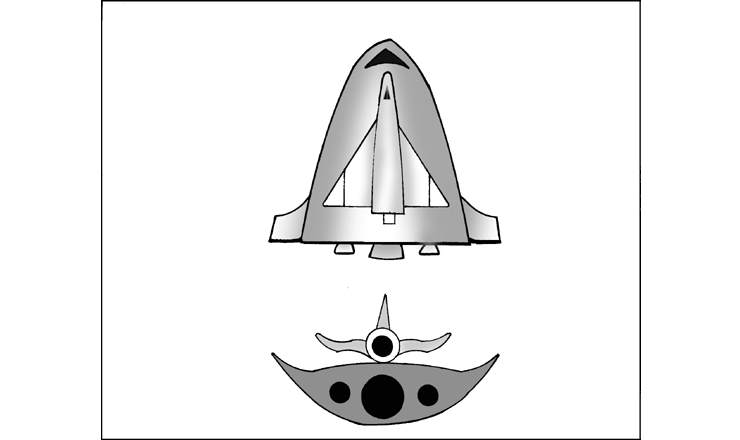|
|
|
|
||||||||||
|
||||||||||||
 |
||||||||||||
|
|
|
 |
|
Alternate Spaceship Configurations
|
|
Evidence of the last 60 or so years to the contrary, three-stage rockets are not the only way to launch payloads into space. Wernher von Braun was the supreme advocate of the brute force approach to space travel: namely, bigger is better. If you needed more payload weight, add another stage or a couple more engines to the first stage. He didn't have time or room in his universe for different approaches. He did, however, sit up and take notice when he was shown a film of a model for a nuclear pulse propulsion design that was in a very early stage of development, but it never was developed to even the test phase. Eventually, of course, we did go to the moon, and we did do it his way, sort of. A rather obscure NASA engineer, over a weekend, came up with the concept of taking to the moon's surface only what was necessary (the Lunar Excursion Module) and leaving the rest (Command Service Module) in orbit around the Moon. That saved enough launch weight to make the von Braun concept work, namely the Saturn 5, and the rest is history. A casualty of the Apollo concept was the iconic 1950ís needle-shaped rocket sitting on its tail on the Moonís surface, a sight made famous in the film Destination Moon and many book and magazine illustrations of the period, as well as many other movies. The difficulty of landing the spaceship is usually glossed over in the movies. An actual landing, with the pilot lying on his back and using a radar altimeter and a TV camera to land the ship on its tail would be impossible for any pilot, even in the one-sixth gravity found on the Moon. Today it is achievable using variable-thrust rocket engines and computer control. Possible, but not easy. Just ask the people at Space-X, who land their booster rockets that way. More realistic is a compact lunar lander, resembling a helicopter rather than a rocket, with the pilot sitting upright (or standing) and the center of thrust and the center of gravity mush closer together than is possible with the traditional rocket design.
After Apollo, we had the Space Shuttle - the ultimate development of 1950's rocket technology. Propelled by liquid hydrogen/oxygen, with higher rocket chamber pressure than Apollo and discardable (but reusable) solid-fuel boosters, the Space Shuttle could launch reasonable payloads into low-earth orbit, and it was reusable. It worked well enough to be the workhorse of the American space program for thirty years. But there must be other ways, maybe even better ways, to achieve the same goal. Just watching an Apollo moon launch shows you the fallacy of the brute force approach. The initial velocity of the spacecraft is zero. It is literally balanced on a column of exhaust gases. Could there be a better way? With the end of the Space Shuttle era and the entry of private space companies such as Space-X supplying the International Space Station, newer, more innovative technologies are emerging that were neglected until recently. Private space companies are taking these more radical ideas and making them work. Let's look at some of those radical ideas. Most alternative configurations involve replacing the first stage of a three-stage rocket with something else: an airplane, a rocket sled, or a rail gun. The first possibility is an airborne, jet-powered, reusable first stage, such as an airplane, carrying the second stage.
The airplane takes off, flies to its maximum altitude and speed and releases the spaceship to continue its journey into space. Think Spaceship 1. This concept is currently being implemented by several private space companies, including Virgin Galactic, which is using a Boeing 747 to provide initial launch. The rocket sled is another alternate approach. It is capable of launching a spacecraft without ever leaving the ground. The concept originated in the late 1930's and became popular in the 1950's. It has several apparent advantages. Since it never leaves the ground, it is totally recoverable and reusable. Also it can be made as large as needed. However, it does have drawbacks. By necessity, it must be miles long. In addition, it is horizontal, although an inclined track is an attractive possibility, especially in the early science fiction movie When Worlds Collide.
This concept, although visually attractive, does have its problems. The movie concept has the spaceship initially blasting down before abruptly changing direction and heading up the side of a mountain and leaping into space. The physical reality is that all the kinetic energy initially built up going down is lost when the spaceship reaches the bottom and starts to climb out.
Not so apparent are the lateral stresses placed on the spaceship by radically changing direction, increasing the weight of the airframe. It does have the advantage of an upward trajectory, although still requiring some sort of aerodynamic lifting capacity, again increasing spacecraft weight, because the rockets aren't firing vertically. The best application of this idea is a ramp inclined at a constant angle. Again, the spaceship has to have aerodynamic lift until it attains sufficient velocity. Another concept very popular during the 1950's was launching the vehicle in sections and assembling it in orbit. A variation on this idea was to launch the spaceship empty and fuel it in space. Although this idea would seem to solve many problems associated with going to the Moon, I suspect it was considered too complicated and risky to be seriously considered in the 1960ís, where beating the Russians to the Moon was a prime consideration. Another concept of the 1950ís was to carry a rocket to an extreme altitude using a giant balloon, and launch the rocket at altitude, bypassing most of the atmosphere. That was actually done with research rockets to increase their maximum altitude. The main drawback to this idea was that the maximum weight of the rocket was limited by the load-carrying capacity of the balloon. Last but not least is a variation of the nuclear pulse rocket idea. In this case a nuclear device is used to launch a spaceship. Basically, the device is buried underground in an extinct volcano and the spaceship is set on top of it. When the nuclear device is detonated, most of the force is directed upward, launching the spacecraft. Among the problems with this method are that a heavy and elaborate system of push plate and shock absorbers is required to make it work, and the launch site is unusable afterward.
|
|
|
|
[Index] [About Us] [Stories] [Guest Art] [Guest Art Page] [Editors Write] [Archives] [Contact Us] [Links] Copyright © 2017 by 4 Star Stories. All Rights Reserved. |





